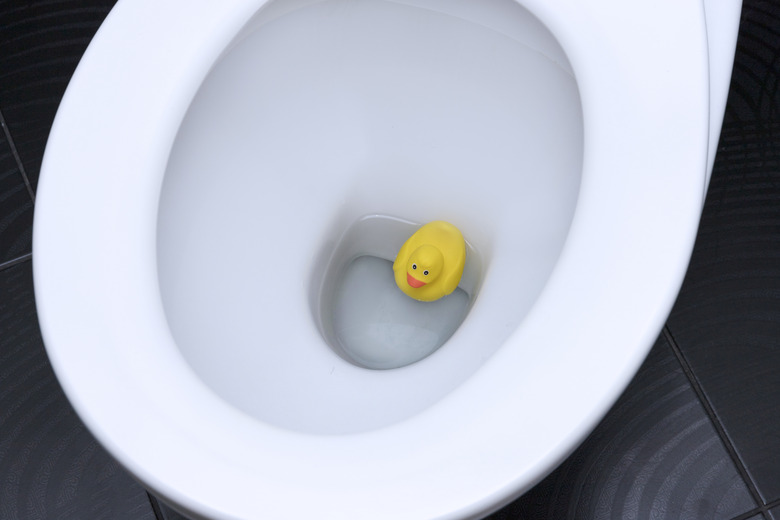How To Retrieve Stuff Flushed Down Toilets
It probably doesn't happen to you often, but you're lucky if you can go through life without needing to retrieve things flushed down a toilet. Sometimes, things get knocked or dropped in accidentally, but oftentimes it results from the shenanigans of a little one deciding to throw everything but the kitchen sink into that big bowl in the bathroom. Whatever the cause, you'll be happy to know there are ways to reclaim what's stuck.
What Happens to Flushed Items?
Things flushed down your toilet — that is, things that are supposed to be flushed — make their way through the toilet's trapway, into the drainpipe, and then into the sewer system. Items not meant to be flushed follow this same path, but sometimes they get stuck in the trapway. If such items sail on through, there's a good chance they'll contribute to blockages down the line, but when the trapway stops them, you'll have a shot at getting them out.
Your best chance at retrieval involves taking up the toilet itself and pulling the item out from the bottom, but this is inconvenient, and if you have to hire a professional for it, it's also expensive. Fortunately, there are other methods to try before things get so complicated, and they're often successful. Before you try anything, scoop water from the toilet bowl using a disposable container and be sure to don plastic gloves.
How to Remove Things Flushed Down the Toilet
Here are a few methods for removing things from the toilet:
1. Reach In With Your Hand
If you can see any part of the item, grab it and pull. If you can't see it, you may be able to feel it by reaching into the bottom of the bowl and sticking your fingers into the trap to pull it out.
2. Hook a Coat Hanger
Straighten a wire coat hanger, forming a small hook at one end. If you can see part of the item, try to catch it and pull. Otherwise, carefully insert the hooked end in the trap to see whether you can feel it and work it out. If you make contact with the item, don't push. Try to go around so you can get the coat hanger hook beneath it and then pull it up. Go easy with the coat hanger so you don't leave scratch marks on the surface of the toilet.
3. Try a Toilet Auger
If you don't have one, rent or buy a toilet auger, also referred to as a closet auger, making sure it's the kind with an open coil head for hooking and retrieving objects. A toilet auger makes use of an extendable and flexible shaft operated with a crank mechanism. Once you feel it grabbing something, simply back it out of the toilet with the crank, ideally retrieving your item.
4. Use a Wet/Dry Vac
Using no attachments, push the hose of a wet/dry vacuum into the drain, stopping if you make contact with the item. Run the vacuum until you hear the object being extracted. If you can't find it in the collection tank of the vacuum, check inside the hose where it may be caught.
5. Pull the Toilet
If none of these methods succeeds, you'll have to take up the toilet. This involves shutting off the water supply, removing any remaining water from the bowl and tank, disconnecting the water line, unbolting the toilet base, and lifting the toilet onto its side so you can see into the trapway from below the base. Toilets are very heavy, so you may need help. If you're not comfortable doing this, call a professional.
Avoid Problems in the Future
Little ones can make a real game out of tossing in toys, car keys, earrings — you name it. Depending on the child, you may be able to explain what a no-no this is and be done with it. On the other hand, you may need to install a lock on your toilet seat that stays until interest in toilet tossing has waned.
It isn't just children who cause problems. Grownups sometimes use the toilet as a waste can, but nothing is designed to dissolve like toilet paper. When you see "flushable" on product packaging, don't fall for it. To avoid serious plumbing problems, remember that only two things should be flushed — human waste and toilet paper — and keep the following items out of the toilet:
- Tissues and paper towels
- Disposable diapers
- Disposable wipes
- Cotton products, like cotton balls, cotton pads, and cotton swabs
- Tampons and sanitary pads
- Food
- Pet fish
- Cooking grease
- Chewing gum
- Hair
- Condoms
- Cat litter — even the "flushable" type
